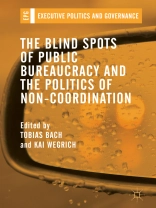How to better coordinate policies and public services across public sector organizations has been a major topic of public administration research for decades. However, few attempts have been made to connect these concerns with the growing body of research on biases and blind spots in decision-making. This book attempts to make that connection. It explores how day-to-day decision-making in public sector organizations is subject to different types of organizational attention biases that may lead to a variety of coordination problems in and between organizations, and sometimes also to major blunders and disasters. The contributions address those biases and their effects for various types of public organizations in different policy sectors and national contexts. In particular, it elaborates on blind spots, or ‘not seeing the not seeing’, and different forms of bureaucratic politics as theoretical explanations for seemingly irrational organizational behaviour. The book’s theoretical tools and empirical insights address conditions for effective coordination and problem-solving by public bureaucracies using an organizational perspective.
Tabla de materias
1. Blind spots, biased attention, and the politics of non-coordination_Tobias Bach and Kai Wegrich.- 2. Accounting for blind spots_Martin Lodge.- 3. Blind spots: organizational and institutional biases in intra- and inter organizational contexts_Tom Christensen.- 4. Professional integrity and leadership in public administration_Wolfgang Seibel.- 5. The alarms that were sent, but never received: attention bias in a novel setting_Helge Renå.- 6. Why cooperation between agencies is (sometimes) possible: turf protection as enabler of regulatory cooperation in the European Union_Eva Heims.- 7. Blame, reputation, and organizational responses to a politicized climate_Markus Hinterleitner and Fritz Sager.- 8. Passing the buck? how risk attitudes shape collaborative innovation in public organizations_Krista Timeus.- 9. Media and bureaucratic reputation: exploring media biases in the coverage of public agencies_Jan Boon, Heidi Houlberg Salomonsen, Koen Verhoest, and Mette Østergaard Pedersen.- 10. Central banks and banking regulation: historical legacies and institutional challenges_Jacint Jordana and Guillermo Rosas.- 11. Why do bureaucrats consider public consultation statements (or not)? information processing in public administration_Simon Fink and Eva Ruffing.- 12. How to deal with the blind spots of public bureaucracies_Tobias Bach and Kai Wegrich.
Sobre el autor
Tobias Bach is Associate Professor of Public Policy and Administration at the Department of Political Science, University of Oslo, Norway.
Kai Wegrich is Professor of Public Administration and Public Policy at the Hertie School of Governance, Berlin, Germany.












